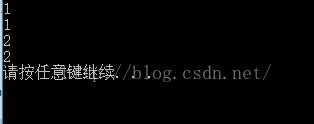- 踩坑,RK3588编译运行rknn的c++例程
血玥珏
rknnc语言c++开发语言
官网:https://github.com/airockchip/rknn-toolkit2下载rknn-toolkit2-master.zip解压缩后cd进入rknn-toolkit2-master/rknpu2/examples/rknn_yolov5_demo将脚本设置可执行chmod777build-linux.sh按照README_CN.md里的说明运行./build-linux.sh-
- 卫星六根数参数预测卫星轨迹
copoer
c++
以下是使用C++编写的基于卫星轨道六根数预测卫星轨迹的代码实现:```cpp#include#includeusingnamespacestd;//地球引力常数(m³/s²)constdoubleMU=3.986004418e14;//三维向量结构体structVector3D{doublex,y,z;Vector3D(doublex_=0,doubley_=0,doublez_=0):x(x_)
- c++对象模式——bind
MARK1998_L
c++开发语言算法
C++中的std::bind是一个工具,用于将函数、成员函数或函数对象与一组特定的参数绑定在一起,从而创建一个新的函数对象。这个新的函数对象可以在稍后调用时使用这些绑定的参数。std::bind通常用于简化函数调用的参数传递、创建回调函数以及结合其他STL组件(如std::function、std::thread等)。机制概述std::bind的基本机制如下:绑定参数:你可以将函数的部分参数或全部
- 【花雕学编程】Arduino ESP32 SPP 之注册简单的SPP回调函数
驴友花雕
嵌入式硬件单片机c++ESP32SPP注册简单的SPP回调函数ArduinoSPP
Arduino是一个开放源码的电子原型平台,它可以让你用简单的硬件和软件来创建各种互动的项目。Arduino的核心是一个微控制器板,它可以通过一系列的引脚来连接各种传感器、执行器、显示器等外部设备。Arduino的编程是基于C/C++语言的,你可以使用ArduinoIDE(集成开发环境)来编写、编译和上传代码到Arduino板上。Arduino还有一个丰富的库和社区,你可以利用它们来扩展Ardui
- 【花雕学编程】Arduino ESP32 SPP 之注册SPP回调函数
驴友花雕
1024程序员节嵌入式硬件单片机c++注册SPP回调函数ArduinoSPPESP32SPP
Arduino是一个开放源码的电子原型平台,它可以让你用简单的硬件和软件来创建各种互动的项目。Arduino的核心是一个微控制器板,它可以通过一系列的引脚来连接各种传感器、执行器、显示器等外部设备。Arduino的编程是基于C/C++语言的,你可以使用ArduinoIDE(集成开发环境)来编写、编译和上传代码到Arduino板上。Arduino还有一个丰富的库和社区,你可以利用它们来扩展Ardui
- 「En」通过DeepSeek生成雅思英语考试学习计划
何曾参静谧
「En」英语从零到一学习英语
✨博客主页何曾参静谧的博客(✅关注、点赞、⭐收藏、转发)全部专栏(专栏会有变化,以最新发布为准)「Win」Windows程序设计「IDE」集成开发环境「定制」定制开发集合「C/C++」C/C++程序设计「DSA」数据结构与算法「UG/NX」NX二次开发「QT」QT5程序设计「File」数据文件格式「UG/NX」BlockUI集合「Py」Python程序设计「Math」探秘数学世界「PK」Paras
- C++跨平台开发:策略与实践在软件开发领域
饼干帅成渣
c++开发语言
在软件开发领域,跨平台能力意味着一个应用程序可以在不同的操作系统上运行,无需针对每个平台单独编写代码。C++作为一种强大的编程语言,因其高效性和灵活性,在跨平台开发领域有着广泛的应用。本文将探讨C++跨平台开发的关键策略与实践方法。一、跨平台开发面临的挑战操作系统差异:不同的操作系统(如Windows、Linux、macOS)在文件系统、进程管理、内存分配等方面存在差异。编译器差异:不同的编译器(
- C++ 智能指针 unique_ptr shared_ptr weak_ptr小练习
TsuanS
c++算法开发语言
智能指针是C++11引入的一项重要特性,它可以帮助我们管理动态分配的内存,自动释放内存,避免内存泄漏和悬空指针的问题。智能指针有三种常用类型:std::unique_ptr、std::shared_ptr和std::weak_ptr。为了帮助你熟悉智能指针的使用,下面是一些练习题,涵盖了智能指针的基本用法以及一些常见的应用场景。练习1:使用std::unique_ptr任务:创建一个std::un
- <functional>的使用详解
TsuanS
c++算法开发语言
C++中的库用于函数对象和回调函数的处理,功能非常强大,能够让我们更加灵活地操作函数和其他可调用对象。1.什么是库?是C++标准库中的一个头文件,包含了用于处理函数对象(functor)和回调函数的工具。它让我们能够更加灵活地操作函数,尤其是那些作为参数传递或返回值的函数。常用组件:std::function:存储任意类型的可调用对象(函数、lambda、函数指针等)。std::bind:用于绑定
- C++ 模板 简单易懂
TsuanS
c++算法开发语言
简单易懂的比喻+代码示例+逐步递进,让你学得轻松又扎实!1️⃣模板(Template)是什么?先来个简单的例子假设你写了一个计算两个数之和的函数:intadd(inta,intb){returna+b;}✅可以处理整数int,但如果想计算小数double呢?你得再写一个函数:doubleadd(doublea,doubleb){returna+b;}⚠️问题:代码重复!不同类型的数据都要单独实现,
- Muduo常用接口
TsuanS
c++
Muduo是一个基于C++的高性能、非阻塞I/O的网络库,主要用于处理高并发的网络通信。它封装了Linux上的epoll和pthread,实现了事件驱动的网络编程模型。Muduo的设计理念是将网络I/O与业务逻辑解耦,通过Reactor模型来管理I/O事件。常用接口介绍在Muduo中,主要有以下几类接口和类:1.EventLoopEventLoop是Muduo的核心类之一,它代表了一个事件循环。每
- 全面理解-函数对象(仿函数)
HL_LOVE_C
C/C++算法c++开发语言仿函数C++11函数对象
函数对象(FunctionObject),也被称为仿函数(Functor),是C++中一种具有函数行为的对象。它结合了对象和函数的特性,使得对象可以像函数一样被调用。定义函数对象是一个重载了函数调用运算符()的类或结构体的对象。当该对象使用()运算符时,就像调用一个普通函数一样。实现要创建一个函数对象,需要定义一个类或结构体,并在其中重载()运算符。以下是一个简单的函数对象示例:#include/
- c++内存管理
HL_LOVE_C
C/C++开发语言c++
在C++中,内存管理是程序设计的核心问题之一,直接影响程序的性能、稳定性和安全性。C++允许开发者直接操作内存,但也要求开发者对内存分配和释放负全责。以下是C++内存管理的全面解析:一、内存布局C++程序的内存通常分为以下几个区域:内存区域用途生命周期栈(Stack)存储局部变量、函数参数、返回值等函数调用时分配,结束时释放堆(Heap)动态分配的内存(通过new/malloc申请,delete/
- 全面理解-函数指针
HL_LOVE_C
C/C++c++开发语言操作系统
定义函数指针是指向函数的指针变量,它存储的是函数的入口地址。通过函数指针,可以像调用普通函数一样调用其所指向的函数。函数指针是C/C++中的一个重要概念,它允许将函数作为参数传递给其他函数、存储函数的地址并在需要时调用函数。声明函数指针的声明需要指定函数的返回类型和参数列表。一般形式如下:return_type(*pointer_name)(parameter_list);return_type:
- C++,std::bind 详解
智驾
C/C++c++stdbind
文章目录1.概述2.基本用法2.1使用占位符2.2示例3.总结1.概述std::bind是C++11引入的一个功能,它允许你将函数(或成员函数、函数对象)与其参数绑定,生成一个新的可调用对象。这个功能在需要将函数及其参数一起传递给其他函数或存储起来稍后调用时非常有用。std::bind返回的是一个std::function对象,它可以在任何需要函数对象的地方使用。2.基本用法std::bind的基
- c++中sleep是什么意思(不是Sleep() )
饼干帅成渣
c++开发语言
sleep函数在C语言中用于暂停程序执行指定的秒数,语法为sleep(unsignedintseconds)。当seconds为0时,函数立即返回,否则函数将使进程暂停指定的秒数,并返回实际暂停的时间。sleep函数在C++中的含义sleep函数是C标准库中提供的函数,用于暂停程序执行一段指定的时间。功能:sleep函数将使调用进程暂停执行指定的秒数。如果指定的秒数为0,则函数立即返回,不会暂停程
- C++STL容器之set
画个逗号给明天"
C++之STL容器c++开发语言
1.介绍set容器是C++标准模板库(STL)中的一个关联容器,用于存储唯一的元素。set中的元素是自动排序的,不允许重复。set通常基于红黑树(一种自平衡二叉查找树)实现,因此插入、删除和查找操作的时间复杂度都为O(logn)。2.set用法(1)定义和初始化set的定义和初始化可以通过以下方式完成:std::setmySet;例如,定义一个int类型的set:std::setmySet;//定
- 青少年编程与数学 02-010 C++程序设计基础 01课题、C++语言概要
明月看潮生
编程与数学第02阶段青少年编程c++编程与数学开发语言
青少年编程与数学02-010C++程序设计基础01课题、C++语言概要一、计算机编程语言的发展历史早期萌芽阶段(20世纪40年代-50年代初)高级语言诞生阶段(20世纪50年代中期-60年代)语言多样化阶段(20世纪60年代-70年代)面向对象语言兴起阶段(20世纪80年代-90年代)网络与脚本语言繁荣阶段(20世纪90年代末-21世纪初)现代多元化发展阶段(21世纪初至今)二、C语言的产生和发展
- 2024华为OD机试真题-计算堆栈中的剩余数字(C++)-E卷-100分
2024剑指offer
华为OD机试(C++)2025c++华为od
2024华为OD机试题库-(E卷+C卷+D卷)-(JAVA、Python、C++)目录题目描述输入描述输出描述用例1用例2用例3题目解析代码c++题目描述向一个空栈中依次存入正整数,假设入栈元素n(1≤n≤2^31-1)按顺序依次为:nx...n4、n3、n2、n1,每当元素入栈时,如果n1=n2+...+ny(y的范围[2,x],1≤x≤1000),则n1~ny全部元素出栈,重新入栈新元素m(m
- C++ thread库的使用
我要满血复活
c++jvm开发语言
在C++中,std::thread是C++11引入的线程库的一部分,用于创建和管理线程。它提供了一个简单而强大的方式来实现多线程编程。thread库底层是对各个系统的线程库进⾏封装,如Linux下的pthread库和Windows下Thread库等,所以C++11thread库的第⼀个特点是可以跨平台,第⼆个特点是Linux和Windows下提供的线程库都是⾯向过程的,C++11thread是库⾯
- 2024华为OD机试真题-单词接龙(C++)-E卷B卷-100分
2024剑指offer
华为OD机试(C++)2025c++华为od
2024华为OD机试最新题库-(C卷+D卷+E卷)-(JAVA、Python、C++)目录题目描述:输入描述:输出描述:示例1示例2题目解析考点代码c++题目描述:单词接龙的规则是:可用于接龙的单词首字母必须要前一个单词的尾字母相同;当存在多个首字母相同的单词时,取长度最长的单词,如果长度也相等,则取字典序最小的单词;已经参与接龙的单词不能重复使用。现给定一组全部由小写字母组成单词数组,并指定其中
- 【CXX】4.1 CXX与Cargo集成配置详解
c++
一、规范设置在Rust项目中,为了与C++代码进行互操作,cxxcrate提供了一种便捷的方式。通过cxx-buildcrate,Cargo可以被扩展为一个C++构建系统。这在Cargo.toml文件中通过设置依赖来实现:[dependencies]cxx="1.0"[build-dependencies]cxx-build="1.0"12345build.rs文件是Cargo的构建脚本,它在这里
- Go、Java、Python、C/C++、PHP、Rust 语言全方位对比分析
tekin
Go语言攻坚营Python编程秘籍库javagolangjavac++编程语言对比Python语言PHP语言编程适用场景
简介在当今多元化的编程世界中,不同的编程语言各有千秋,适用于不同的应用场景。本文聚焦于Go、Java、Python、C/C++、PHP和Rust这六种热门编程语言,深入剖析它们的优劣势以及各自的最佳适用场景,旨在为开发者在选择合适的编程语言时提供全面、准确的参考依据。语言优势对比语言优势劣势最佳适用场景Go1.高性能,编译速度快,执行效率接近C/C++。2.强大的并发编程支持,goroutine和
- 【CXX】4.1 CXX与Cargo集成配置详解
Source.Liu
CXXc++rustCXX
一、规范设置在Rust项目中,为了与C++代码进行互操作,cxxcrate提供了一种便捷的方式。通过cxx-buildcrate,Cargo可以被扩展为一个C++构建系统。这在Cargo.toml文件中通过设置依赖来实现:[dependencies]cxx="1.0"[build-dependencies]cxx-build="1.0"build.rs文件是Cargo的构建脚本,它在这里用于配置c
- Linux c++程序结构
weixin_34378922
c/c++操作系统
一个C++程序由含有声明的文本文件序列(通常为头文件与源文件)组成。它们被翻译成一个可执行文件,操作系统通过调用其main函数执行这一程序。在C++程序中,一些被称为关键词的词语有着特殊的含义。其它词语可以被用作标识符。在翻译的过程中,注释会被忽略。程序中的某些字符必须通过转义序列表示。下面我们通过一个简单的例子来说明一个c++程序的最基本元素。#includeusingnamespacestd;
- 【总序】底层语言发展史
红栈说BSP
c语言c++汇编
目录机器语言汇编语言C语言C++注机器语言计算机发明之初,人们为了去控制计算机完成自己的任务或者项目,只能去编写“0”、“1”这样的二进制数字串去控制电脑,其实就是控制计算机硬件的高低电平或通路开路,这种语言就是机器语言。汇编语言为方便工程师的编程工作,我们将一些特定的由“0”和“1”组成的字符串看作指令,做出了汇编语言。但是,由于它仍然是面向机器的,所以不够高级。而且因此,我们学汇编开发前,需要
- 咱们一起学C++ 第二百七十八篇之C++模板进阶与容器类的新探索
一杯年华@编程空间
咱们一起学习C++c++numpy开发语言
咱们一起学C++第二百七十八篇之C++模板进阶与容器类的新探索大家好!C++的学习之旅充满了挑战与惊喜,今天咱们接着深入探讨C++的模板知识,同时看看模板在容器类中的奇妙应用,希望在这个过程中,大家都能有所收获,一起在C++编程的海洋里遨游,不断提升自己的编程能力!一、模板参数的多样化使用在C++模板的世界里,模板参数的运用十分灵活。以往我们常见的模板参数是类型参数,就像之前定义的模板类,用typ
- QQ游戏百万人同时在线服务器架构实现
JsenLong
QQ游戏于前几日终于突破了百万人同时在线的关口,向着更为远大的目标迈进,这让其它众多传统的棋牌休闲游戏平台黯然失色,相比之下,联众似乎已经根本不是QQ的对手,因为QQ除了这100万的游戏在线人数外,它还拥有3亿多的注册量(当然很多是重复注册的)以及QQ聊天软件900万的同时在线率,我们已经可以预见未来由QQ构建起来的强大棋牌休闲游戏帝国。服务器程序,其可承受的同时连接数目是有理论峰值的,通过C++
- 【C++】35.智能指针(2)
流星白龙
C++学习c++开发语言
文章目录5.shared_ptr和weak_ptr5.1shared_ptr循环引用问题5.2weak_ptr6.shared_ptr的线程安全问题7.C++11和boost中智能指针的关系8.内存泄漏8.1什么是内存泄漏,内存泄漏的危害8.2如何检测内存泄漏(了解)8.3如何避免内存泄漏9.定制删除器5.shared_ptr和weak_ptr5.1shared_ptr循环引用问题shared_p
- 【类与对象】--对象之舞,类之华章,共绘C++之美
不会写代码的ys
c++
前言在C++中,构造函数、析构函数和拷贝构造函数是管理对象生命周期的关键功能。这三者在类的使用中起着至关重要的作用,它们帮助程序员负责对象的创建、内存管理以及对象间的复制。本文将详细探讨这三种函数的定义、特点以及使用示例,帮助你更好地理解这些概念。目录一、类的定义二、构造函数三、析构函数四、拷贝构造函数五、运算符重载5.1为什么需要赋值运算符重载5.2赋值运算符重载的实现5.3测试实现六、友元6.
- Spring中@Value注解,需要注意的地方
无量
springbean@Valuexml
Spring 3以后,支持@Value注解的方式获取properties文件中的配置值,简化了读取配置文件的复杂操作
1、在applicationContext.xml文件(或引用文件中)中配置properties文件
<bean id="appProperty"
class="org.springframework.beans.fac
- mongoDB 分片
开窍的石头
mongodb
mongoDB的分片。要mongos查询数据时候 先查询configsvr看数据在那台shard上,configsvr上边放的是metar信息,指的是那条数据在那个片上。由此可以看出mongo在做分片的时候咱们至少要有一个configsvr,和两个以上的shard(片)信息。
第一步启动两台以上的mongo服务
&nb
- OVER(PARTITION BY)函数用法
0624chenhong
oracle
这篇写得很好,引自
http://www.cnblogs.com/lanzi/archive/2010/10/26/1861338.html
OVER(PARTITION BY)函数用法
2010年10月26日
OVER(PARTITION BY)函数介绍
开窗函数 &nb
- Android开发中,ADB server didn't ACK 解决方法
一炮送你回车库
Android开发
首先通知:凡是安装360、豌豆荚、腾讯管家的全部卸载,然后再尝试。
一直没搞明白这个问题咋出现的,但今天看到一个方法,搞定了!原来是豌豆荚占用了 5037 端口导致。
参见原文章:一个豌豆荚引发的血案——关于ADB server didn't ACK的问题
简单来讲,首先将Windows任务进程中的豌豆荚干掉,如果还是不行,再继续按下列步骤排查。
&nb
- canvas中的像素绘制问题
换个号韩国红果果
JavaScriptcanvas
pixl的绘制,1.如果绘制点正处于相邻像素交叉线,绘制x像素的线宽,则从交叉线分别向前向后绘制x/2个像素,如果x/2是整数,则刚好填满x个像素,如果是小数,则先把整数格填满,再去绘制剩下的小数部分,绘制时,是将小数部分的颜色用来除以一个像素的宽度,颜色会变淡。所以要用整数坐标来画的话(即绘制点正处于相邻像素交叉线时),线宽必须是2的整数倍。否则会出现不饱满的像素。
2.如果绘制点为一个像素的
- 编码乱码问题
灵静志远
javajvmjsp编码
1、JVM中单个字符占用的字节长度跟编码方式有关,而默认编码方式又跟平台是一一对应的或说平台决定了默认字符编码方式;2、对于单个字符:ISO-8859-1单字节编码,GBK双字节编码,UTF-8三字节编码;因此中文平台(中文平台默认字符集编码GBK)下一个中文字符占2个字节,而英文平台(英文平台默认字符集编码Cp1252(类似于ISO-8859-1))。
3、getBytes()、getByte
- java 求几个月后的日期
darkranger
calendargetinstance
Date plandate = planDate.toDate();
SimpleDateFormat df = new SimpleDateFormat("yyyy-MM-dd");
Calendar cal = Calendar.getInstance();
cal.setTime(plandate);
// 取得三个月后时间
cal.add(Calendar.M
- 数据库设计的三大范式(通俗易懂)
aijuans
数据库复习
关系数据库中的关系必须满足一定的要求。满足不同程度要求的为不同范式。数据库的设计范式是数据库设计所需要满足的规范。只有理解数据库的设计范式,才能设计出高效率、优雅的数据库,否则可能会设计出错误的数据库.
目前,主要有六种范式:第一范式、第二范式、第三范式、BC范式、第四范式和第五范式。满足最低要求的叫第一范式,简称1NF。在第一范式基础上进一步满足一些要求的为第二范式,简称2NF。其余依此类推。
- 想学工作流怎么入手
atongyeye
jbpm
工作流在工作中变得越来越重要,很多朋友想学工作流却不知如何入手。 很多朋友习惯性的这看一点,那了解一点,既不系统,也容易半途而废。好比学武功,最好的办法是有一本武功秘籍。研究明白,则犹如打通任督二脉。
系统学习工作流,很重要的一本书《JBPM工作流开发指南》。
本人苦苦学习两个月,基本上可以解决大部分流程问题。整理一下学习思路,有兴趣的朋友可以参考下。
1 首先要
- Context和SQLiteOpenHelper创建数据库
百合不是茶
androidContext创建数据库
一直以为安卓数据库的创建就是使用SQLiteOpenHelper创建,但是最近在android的一本书上看到了Context也可以创建数据库,下面我们一起分析这两种方式创建数据库的方式和区别,重点在SQLiteOpenHelper
一:SQLiteOpenHelper创建数据库:
1,SQLi
- 浅谈group by和distinct
bijian1013
oracle数据库group bydistinct
group by和distinct只了去重意义一样,但是group by应用范围更广泛些,如分组汇总或者从聚合函数里筛选数据等。
譬如:统计每id数并且只显示数大于3
select id ,count(id) from ta
- vi opertion
征客丶
macoprationvi
进入 command mode (命令行模式)
按 esc 键
再按 shift + 冒号
注:以下命令中 带 $ 【在命令行模式下进行】,不带 $ 【在非命令行模式下进行】
一、文件操作
1.1、强制退出不保存
$ q!
1.2、保存
$ w
1.3、保存并退出
$ wq
1.4、刷新或重新加载已打开的文件
$ e
二、光标移动
2.1、跳到指定行
数字
- 【Spark十四】深入Spark RDD第三部分RDD基本API
bit1129
spark
对于K/V类型的RDD,如下操作是什么含义?
val rdd = sc.parallelize(List(("A",3),("C",6),("A",1),("B",5))
rdd.reduceByKey(_+_).collect
reduceByKey在这里的操作,是把
- java类加载机制
BlueSkator
java虚拟机
java类加载机制
1.java类加载器的树状结构
引导类加载器
^
|
扩展类加载器
^
|
系统类加载器
java使用代理模式来完成类加载,java的类加载器也有类似于继承的关系,引导类是最顶层的加载器,它是所有类的根加载器,它负责加载java核心库。当一个类加载器接到装载类到虚拟机的请求时,通常会代理给父类加载器,若已经是根加载器了,就自己完成加载。
虚拟机区分一个Cla
- 动态添加文本框
BreakingBad
文本框
<script> var num=1; function AddInput() { var str=""; str+="<input
- 读《研磨设计模式》-代码笔记-单例模式
bylijinnan
java设计模式
声明: 本文只为方便我个人查阅和理解,详细的分析以及源代码请移步 原作者的博客http://chjavach.iteye.com/
public class Singleton {
}
/*
* 懒汉模式。注意,getInstance如果在多线程环境中调用,需要加上synchronized,否则存在线程不安全问题
*/
class LazySingleton
- iOS应用打包发布常见问题
chenhbc
iosiOS发布iOS上传iOS打包
这个月公司安排我一个人做iOS客户端开发,由于急着用,我先发布一个版本,由于第一次发布iOS应用,期间出了不少问题,记录于此。
1、使用Application Loader 发布时报错:Communication error.please use diagnostic mode to check connectivity.you need to have outbound acc
- 工作流复杂拓扑结构处理新思路
comsci
设计模式工作算法企业应用OO
我们走的设计路线和国外的产品不太一样,不一样在哪里呢? 国外的流程的设计思路是通过事先定义一整套规则(类似XPDL)来约束和控制流程图的复杂度(我对国外的产品了解不够多,仅仅是在有限的了解程度上面提出这样的看法),从而避免在流程引擎中处理这些复杂的图的问题,而我们却没有通过事先定义这样的复杂的规则来约束和降低用户自定义流程图的灵活性,这样一来,在引擎和流程流转控制这一个层面就会遇到很
- oracle 11g新特性Flashback data archive
daizj
oracle
1. 什么是flashback data archive
Flashback data archive是oracle 11g中引入的一个新特性。Flashback archive是一个新的数据库对象,用于存储一个或多表的历史数据。Flashback archive是一个逻辑对象,概念上类似于表空间。实际上flashback archive可以看作是存储一个或多个表的所有事务变化的逻辑空间。
- 多叉树:2-3-4树
dieslrae
树
平衡树多叉树,每个节点最多有4个子节点和3个数据项,2,3,4的含义是指一个节点可能含有的子节点的个数,效率比红黑树稍差.一般不允许出现重复关键字值.2-3-4树有以下特征:
1、有一个数据项的节点总是有2个子节点(称为2-节点)
2、有两个数据项的节点总是有3个子节点(称为3-节
- C语言学习七动态分配 malloc的使用
dcj3sjt126com
clanguagemalloc
/*
2013年3月15日15:16:24
malloc 就memory(内存) allocate(分配)的缩写
本程序没有实际含义,只是理解使用
*/
# include <stdio.h>
# include <malloc.h>
int main(void)
{
int i = 5; //分配了4个字节 静态分配
int * p
- Objective-C编码规范[译]
dcj3sjt126com
代码规范
原文链接 : The official raywenderlich.com Objective-C style guide
原文作者 : raywenderlich.com Team
译文出自 : raywenderlich.com Objective-C编码规范
译者 : Sam Lau
- 0.性能优化-目录
frank1234
性能优化
从今天开始笔者陆续发表一些性能测试相关的文章,主要是对自己前段时间学习的总结,由于水平有限,性能测试领域很深,本人理解的也比较浅,欢迎各位大咖批评指正。
主要内容包括:
一、性能测试指标
吞吐量、TPS、响应时间、负载、可扩展性、PV、思考时间
http://frank1234.iteye.com/blog/2180305
二、性能测试策略
生产环境相同 基准测试 预热等
htt
- Java父类取得子类传递的泛型参数Class类型
happyqing
java泛型父类子类Class
import java.lang.reflect.ParameterizedType;
import java.lang.reflect.Type;
import org.junit.Test;
abstract class BaseDao<T> {
public void getType() {
//Class<E> clazz =
- 跟我学SpringMVC目录汇总贴、PDF下载、源码下载
jinnianshilongnian
springMVC
----广告--------------------------------------------------------------
网站核心商详页开发
掌握Java技术,掌握并发/异步工具使用,熟悉spring、ibatis框架;
掌握数据库技术,表设计和索引优化,分库分表/读写分离;
了解缓存技术,熟练使用如Redis/Memcached等主流技术;
了解Ngin
- the HTTP rewrite module requires the PCRE library
流浪鱼
rewrite
./configure: error: the HTTP rewrite module requires the PCRE library.
模块依赖性Nginx需要依赖下面3个包
1. gzip 模块需要 zlib 库 ( 下载: http://www.zlib.net/ )
2. rewrite 模块需要 pcre 库 ( 下载: http://www.pcre.org/ )
3. s
- 第12章 Ajax(中)
onestopweb
Ajax
index.html
<!DOCTYPE html PUBLIC "-//W3C//DTD XHTML 1.0 Transitional//EN" "http://www.w3.org/TR/xhtml1/DTD/xhtml1-transitional.dtd">
<html xmlns="http://www.w3.org/
- Optimize query with Query Stripping in Web Intelligence
blueoxygen
BO
http://wiki.sdn.sap.com/wiki/display/BOBJ/Optimize+query+with+Query+Stripping+in+Web+Intelligence
and a very straightfoward video
http://www.sdn.sap.com/irj/scn/events?rid=/library/uuid/40ec3a0c-936
- Java开发者写SQL时常犯的10个错误
tomcat_oracle
javasql
1、不用PreparedStatements 有意思的是,在JDBC出现了许多年后的今天,这个错误依然出现在博客、论坛和邮件列表中,即便要记住和理解它是一件很简单的事。开发者不使用PreparedStatements的原因可能有如下几个: 他们对PreparedStatements不了解 他们认为使用PreparedStatements太慢了 他们认为写Prepar
- 世纪互联与结盟有感
阿尔萨斯
10月10日,世纪互联与(Foxcon)签约成立合资公司,有感。
全球电子制造业巨头(全球500强企业)与世纪互联共同看好IDC、云计算等业务在中国的增长空间,双方迅速果断出手,在资本层面上达成合作,此举体现了全球电子制造业巨头对世纪互联IDC业务的欣赏与信任,另一方面反映出世纪互联目前良好的运营状况与广阔的发展前景。
众所周知,精于电子产品制造(世界第一),对于世纪互联而言,能够与结盟


